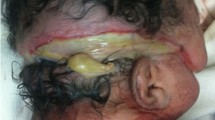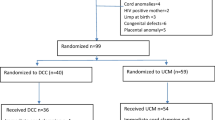Abstract
Antenatal detection of anterior abdominal wall defects (gastroschisis and exomphalos) enables detailed prenatal planning and counselling with appropriate intrauterine transfer, delivery in a tertiary referral centre with prompt access to paediatric surgery and early surgical intervention. The authors believed that there was a relatively low rate of antenatal detection in Ireland and that an improved antenatal screening program would allow increased detection thus avoiding emergency retrievals from peripheral obstetric centres. Our hypothesis was that there was a significant difference in management and outcome in children with anterior abdominal wall defects detected antenatally and those detected at birth. All anterior abdominal wall defects in The Republic of Ireland are assessed and closed in two surgical centres, Our Lady’s Hospital for Sick Children, and the Children’s University Hospital, Dublin. A retrospective review of all admissions in both centres revealed 96 neonates with anterior wall defects (excluding bladder exstrophy and cloaca) over a 7 year period from 1998 to 2004 inclusive. Medical records, operative reports, neonatal databases and admission details were reviewed. The antenatal data search included anomaly detection, prenatal management plan and intrauterine transfer. Perinatal data included place of birth, weight, gestational age, mode of delivery, time to surgery and type of surgery, the time to establish full enteral feeding and the length of hospital stay were used as overall markers of outcome. Fifty-three patients had gastroschisis and 43 exomphalos with an antenatal detection rate of 53% (n = 28) and 34% (n = 15), respectively, with an overall detection rate of 44%. There was no significant difference in the median birth weight (2.83 vs. 2.85 kg), gestational age at birth (37 vs. 37 weeks), time to full feeding (12 vs.14 days) and length of stay (20 vs. 17 days) between those detected antenatally or postnatally, respectively. About 77 had a primary closure performed of which 63 infants had surgery within the first 24 h of life. There was no difference in the time to surgery, frequency of complications or the surgical outcome in either group. Intrauterine transfer did not affect any outcome measure assessed. The demographics and the presence of associated anomalies did not differ between the groups. The hypothesis that antenatal diagnosis in anterior abdominal wall defects improves outcome has been demonstrated to be false. Despite this result, the importance of antenatal screening and prenatal management of complex foetal conditions with consultation with experienced paediatric and neonatal staff is without doubt.
Similar content being viewed by others
References
Quirk JG, Fortney J, Collins HB, et al (1996) Outcomes of newborns with gastroschisis: the effects of mode of delivery, site of delivery, and interval from birth to surgery. Am J Obstet Gynecol 174:1134–1138
Rygl M, Kalousova J, Pycha K, et al (2004) Current results in treatment of omphalocele and gastroschisis. Ceska Gynekol 69:55–9
Haddock G, Davis CF, Raine PA (1996) Gastroschisis in the decade of prenatal diagnosis: 1983–93. Eur J Pediatr Surg 6:18–22
Axt R, Quijano F, Boos R, et al (1999) Omphalocele and gastroschisis: prenatal diagnosis and peripartal management. A case analysis of the years 1989–1997 at the Department of Obstetrics and Gynecology, University of Homburg/Saar. Eur J Obstet Gynecol Reprod Biol 87:47–54
Holland AJ, Ford WD, Linke RJ, et al (1999) Influence of antenatal ultrasound on the management of fetal exomphalos. Fetal Diagn Ther 14:223–228
Salihu HM, Boos R, Schmidt W (2002) Omphalocele and gastrochisis. J Obstet Gynaecol 22:489–492
Fong WK, Toi A, Salem S, et al (2004) Detection of fetal structural abnormalities with US during early pregnancy. Radiographics 24:157–174
Chilarski A, Bulhak-Guz H, Grochulska-Cerska H (2005) Evaluation of surgical treatment in gastroschisis based on personal experience. Med Wieku Rozwoj 9:383–393
Moir CR, Ramsey PS, Ogburn PL, et al (2004) A prospective trial of elective preterm delivery for fetal gastroschisis. Am J Perinatol 21:289–294
Japaraj RP, Hockey R, Chan FY (2003) Gastroschisis: can prenatal sonography predict neonatal outcome? Ultrasound Obstet Gynecol 21:329–333
Piper HG, Jaksic T (2006) The impact of prenatal bowel dilation on clinical outcomes in neonates with gastroschisis. J Pediatr Surg 41:897–900
Huang J, Kurkchubasche AG, Carr SR, et al (2002) Benefits of term delivery in infants with antenatally diagnosed gastroschisis. Obstet Gynecol 100:695–699
Logghe HL, Mason GC, Thornton JG, et al (2005) A randomized controlled trial of elective preterm delivery of fetuses with gastroschisis. J Pediatr Surg 40:1726–1731
Vegunta RK, Wallace LJ, Leonardi MR, et al (2005) Perinatal management of gastroschisis: analysis of a newly established clinical pathway. J Pediatr Surg 40:528–34
Durfee SM, Downard CD, Benson CB, et al (2002) Postnatal outcome of fetuses with the prenatal diagnosis of gastroschisis. J Ultrasound Med 21:269–274
Barisic I, Clementi M, Hausler M, et al (2001) Evaluation of prenatal ultrasound diagnosis of fetal abdominal wall defects by 19 European registries. Ultrasound Obstet Gynecol 18:309–316
Blazer S, Zimmer EZ, Gover A, et al (2004) Fetal omphalocele detected early in pregnancy: associated anomalies and outcomes. Radiology 232:191–195
Calzolari E, Bianchi F, Dolk H, et al (1995) Omphalocele and gastroschisis in Europe: a survey of 3 million births 1980–1990. EUROCAT Working Group. Am J Med Genet 58:187–194
Lakasing L, Cicero S, Davenport M, et al (2006) Current outcome of antenatally diagnosed exomphalos: an 11 year review. J Pediatr Surg 41:1403–1406
Kitchanan S, Patole SK, Muller R, et al (2000) Neonatal outcome of gastroschisis and exomphalos: a 10-year review. J Paediatr Child Health 36:428–430
Sakala EP, Erhard LN, White JJ (1993) Elective caesarean section improves outcomes of neonates with gastroschisis. Am J Obstet Gynecol 169:1050–1053
Luton D, Lagausie P, Guibourdenche J, et al (1997) Prognostic factors of prenatally diagnosed gastroschisis. Fetal Diagn Ther 12:7–14
Bagley JS, Lloyd DJ, Gray ES, et al (1996) Small bowel injury in gastroschisis: relation to fetal presentation. Br J Obstet Gynaecol 103:1047–1048
Stringer MD, Brereton RJ, Wright VM (1991) Controversies in the management of gastroschisis: a study of 40 patients. Arch Dis Child 66:34–36
Lewis DF, Towers CV, Garite TJ, et al (1990) Fetal gastroschisis and omphalocele: is cesarean section the best mode of delivery? Am J Obstet Gynecol 163:773–775
Lurie S, Sherman D, Bukovski I (1999) Omphalocele delivery enigma: the bestmode of delivery still remains dubious. Eur J Obstet Gynecol Reprod Biol 82:19–22
Author information
Authors and Affiliations
Corresponding author
Rights and permissions
About this article
Cite this article
Murphy, F.L., Mazlan, T.A., Tarheen, F. et al. Gastroschisis and exomphalos in Ireland 1998–2004. Does antenatal diagnosis impact on outcome?. Pediatr Surg Int 23, 1059–1063 (2007). https://doi.org/10.1007/s00383-007-2001-z
Accepted:
Published:
Issue Date:
DOI: https://doi.org/10.1007/s00383-007-2001-z




